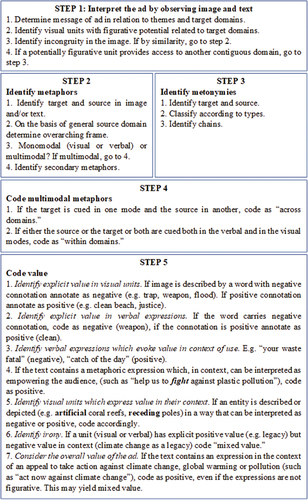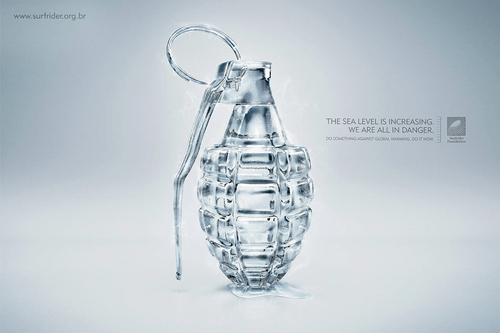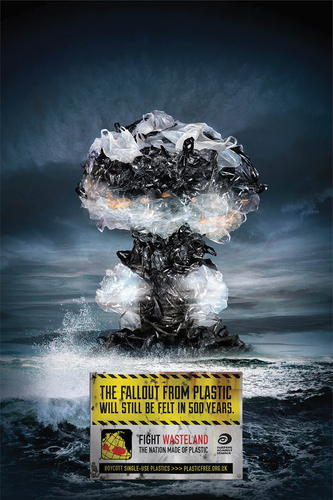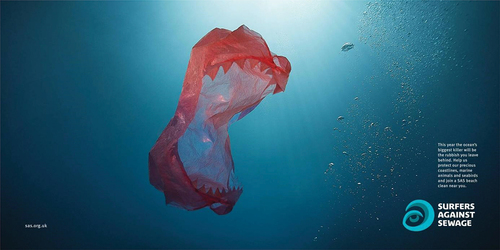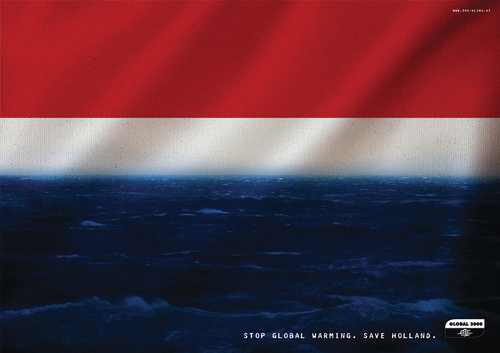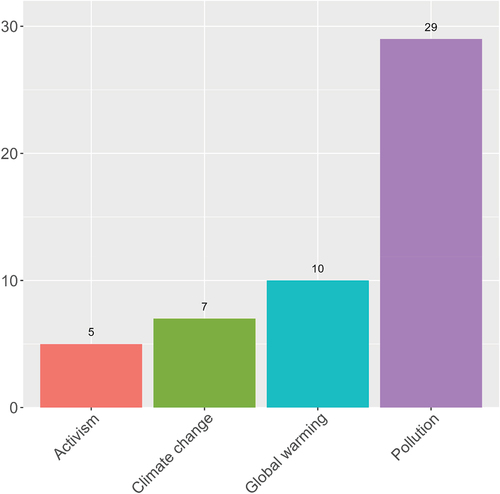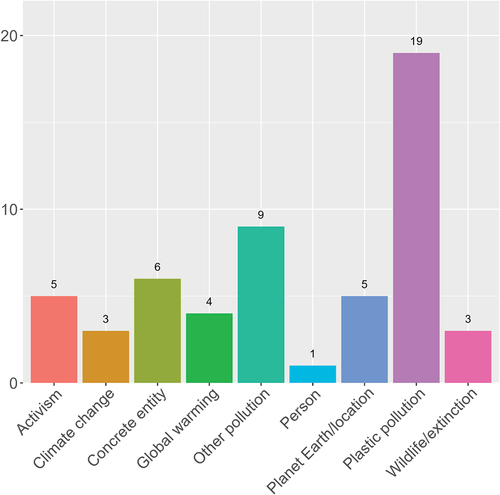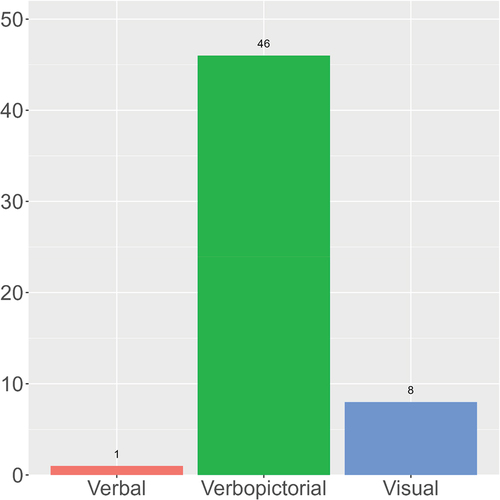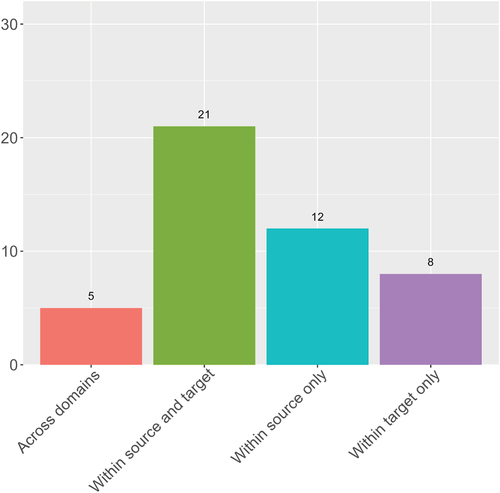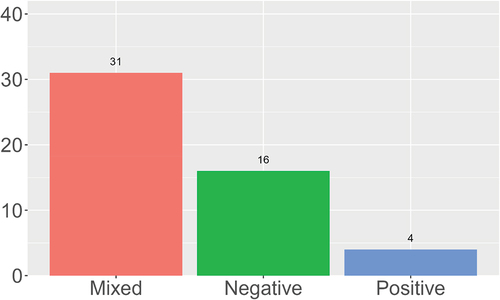ABSTRACT
Concern for global warming, climate change and pollution has grown in recent years, with countries across the world facing natural disasters on unprecedented scales. The communication of environmental protection is therefore a necessary area of enquiry, especially from a Conceptual Metaphor Theory perspective. The present article explores (1) how the themes of global warming, climate change, pollution and activism are conceptualized in a corpus of 51 noncommercial advertisements, (2) the interaction of metonymy with metaphor, (3) the distribution across verbal and visual modes of metaphoric source and target domains, and (4) how value is evoked. Findings show that half of the corpus frames environmental themes through source domains such as weapons, predators and natural disasters. The other half triggers incongruous mappings, such as between concrete entities, and relies on metonymic processes of inference to access the main rhetorical message. Among the most frequent metonymies, CAUSE-EFFECT and CATEGORY FOR SALIENT PROPERTY highlight the negative effects of the represented phenomena. Multimodality usually occurs within source and/or target domains rather than across the metaphoric mapping. Most of the campaigns project mixed value, where a negative evaluation of a theme is accompanied by a positive message, inviting the audience to take action.
Introduction
The Sixth Assessment Report by the Intergovernmental Panel on Climate Change (IPCC) confirms that human-induced climate change is unequivocal and that unprecedented changes are taking place on the planet (IPCC, Citation2021). The release of part one of this report came at a time during which numerous parts of the world were suffering the catastrophic effects of widespread fires and floods, on previously unrecorded scales. The current situation makes the communication of environmental protection and climate change a necessary and important area of enquiry for the study of metaphor and metonymy in discourse. In terms of public engagement, metaphors are important framing devices that effectively help us to understand and relate to complex environmental issues (Koteyko & Atanasova, Citation2016; Nisbet & Mooney, Citation2007, Väliverronen & Hellsten, 2022) They do this through connecting abstract phenomena such as climate change (target domain) to concrete, familiar experiences (source domain), thus helping to construct statements and opinions about complex topics and debates. In this sense, metaphor choice in the communication of environmental issues may involve the popularization of complex scientific concepts so as to make them accessible to a broad audience (Koteyko & Atanasova, Citation2016, p. 297).
Metaphor selection is a highly controversial issue, since such choices can have an important influence on how the public interprets the represented events and perceives the appropriate course of action (Domínguez, Citation2015; Koteyko & Atanasova, Citation2016; Semino, Citation2021; Semino, Demjén, Hardie, Payne, & Rayson, Citation2017). It has been argued that the main difficulty involved in the (visual) communication of climate change is how to make audiences aware of a problem that is often invisible or latent, whose effects are only perceivable over long periods of time, once they have happened (Doyle, Citation2007, Citation2011). One of the strategies adopted by communicators is to visualize the imagined future of the planet affected by climate change and pollution to highlight the devastating effects of past and present (in)action, which make visible the results of a long-term process (Doyle, Citation2007, p. 129). This focus on the negative effects of climate change by activists (cf. Cunningham, Foxcroft, & Sauntson, Citation2022), however, may often evoke feelings of danger and threat rather than promote the advantages of protecting our natural environment, and has been criticized on numerous occasions, with calls for media coverage and NGOs to prioritize solutions-oriented discussions of climate change (Doyle, Citation2007, p. 129). A similar controversy is found in recent research within Conceptual Metaphor Theory, where experimental research suggests that in comparison to RACE metaphors, WAR metaphors for climate change in verbal texts contribute to arousing in the public more urgency, and encourage better conservation efforts. The longer-term framing effects of these metaphors, however, are unknown. In multimodal contexts, research on “shockvertising” advertisements (Pérez-Sobrino, Citation2016a) finds that highly creative metaphorical mappings can serve to highlight controversial social and environmental issues in a way that may more successfully engage the audience. Metaphor choice thus appears to have important implications for public engagement in environmental discourses, including the design of environmental campaigns.
Against this background, the motivation of the present article is to explore how metaphor and metonymy contribute to the conceptualization of the topics of climate change, global warming, pollution, and environmental activism, in a corpus of 51 noncommercial advertisements and posters. In order to do so, our article addresses some relevant issues in the study of multimodal advertising discourse. First, it is worth pointing out that although the study of metaphors used to conceptualize climate change is a hot topic, this has mostly been restricted to the study of verbal discourse, whilst some cognitive approaches to multimodal and visual metaphor exist but are limited (Augé, Citation2022; Cozen, Citation2013; Mühlhäusler, Citation1999; Pérez-Sobrino, Citation2016a). Less attention, moreover, has been paid to the figurative framing of related issues such as pollution. Secondly, most existing research in cognitive linguistics on climate change and environmental issues has focused on metaphor and paid little attention to other tropes such as metonymy. However, following previous research on the study of the interaction between metaphor and metonymy in multimodal advertising discourse (cf. Hidalgo-Downing & Kraljevic Mujic, Citation2011; Kashanizadeh & Forceville, Citation2020; Pérez-Sobrino, Citation2016a, Citation2016b, Citation2017; Pérez-Sobrino, Littlemore, & Ford, Citation2021), we argue that the analysis of metonymy and its interaction with metaphor provides crucial clues as to the way in which important matters of environmental awareness are construed in our corpus. Third, we study the distribution of target and source domains across verbal and visual modes, in order to determine whether multimodality occurs across the mapping (for example, the target may be expressed in the verbal mode and the source in the visual mode) or within one or both conceptual domains (for example, the target and/or source domain may be expressed both in the verbal and in the visual modes). This can potentially reveal differences between the role of multimodality in noncommercial advertising discourse in comparison to other multimodal genres (Pérez-Sobrino, Citation2016a; Pérez-Sobrino et al., Citation2021). Fourth, most research on multimodal metaphor and metonymy in advertising discourse has focused on commercial advertising, while less attention has been paid to noncommercial advertising (for exceptions, see Pérez-Sobrino, Citation2016a, Citation2016b, Citation2017; Pérez-Sobrino et al., Citation2021) . Noncommercial advertising poses interesting challenges for the analysis of the interaction between metaphor and metonymy since it does not focus on promoting the positive properties of a product, “but rather at denouncing an unfair or potentially dangerous situation” (Pérez-Sobrino, Citation2016b, p. 75). However, studies on noncommercial advertising do not account for how value is projected and most existing research on value has focused on the evaluative potential of metaphors in verbal discourse (Deignan, Citation2010; Fuoli, Littlemore, & Turner, Citation2021; Hidalgo-Downing & Pérez-Sobrino, Citation2022; Semino, Citation2008; Semino et al., Citation2017). The present study draws from existing procedures for the identification of verbal, visual and multimodal metaphors and metonymies (Forceville, Citation2009; Pérez-Sobrino, Citation2016a, Citation2016b, Citation2017; Pérez-Sobrino et al., Citation2021; Šorm & Steen, Citation2018; Steen et al., Citation2010) and proposes a method for the identification of these figurative operations in the corpus, which also includes the identification of value.
Our research questions are the following:
(1) How are the main themes (climate change, global warming, pollution and environmental activism) conceptualized metaphorically?
(2) What types of metonymies interact with the metaphors?
(3) How are the metaphoric source and target domains distributed across modes?
(4) To what extent do the ads project value, and, if so, of what type?
The rest of the article is organized as follows. We first provide an overview of the theoretical concepts which underpin our study, namely, relevant research on metaphor in the conceptualization of climate change and environmental awareness and research on metaphor and metonymy as discourse strategies in multimodal advertising. We then explain the data analyzed and the methods adopted in this study, followed by a discussion of the results and some representative examples from the corpus in relation to each of the research questions. The article closes with some conclusions, limitations of the study and suggestions for further research.
Theoretical concepts
Metaphor as a framing device in discourse on climate change and environmental awareness
In studies on environmental communication, experts have advocated for the affective functions of metaphor, deeming metaphors effective public engagement tools (Nerlich, Koteyko, & Brown, Citation2010). In corpus studies, WAR, RACE and RELIGION source domains have been found to dominate debates on climate change (Atanasova & Koteyko, Citation2017). Whilst on the one hand, WAR metaphors have been found to generate an increased sense of urgency around the environmental crisis and to characterize the delicacy of the political debates that surround it (Flusberg, Matlock, & Thibodeau, Citation2017; Koteyko & Atanasova, Citation2016), they have also been seen to unite audiences through emphasizing the gravity of the issue, and, on occasion, through harking back to wartime eras where all types of consumption were drastically limited (Cohen, Citation2011; Cozen, Citation2013). On the other hand, RELIGION metaphors have been found to downplay, undermine or de-legitimize awareness raising campaigns through conceptualizing climate change mitigation attitudes as radical or extremist (Atanasova & Koteyko, Citation2017).
Other source domains that have been studied in previous research on climate discourses are GREENHOUSE and TRAP (Deignan, Semino, & Paul, Citation2019), MACHINE, TIPPING POINT, BODY/PATIENT/HEALTH and FOOTPRINT (Augé, Citation2022; Koteyko & Atanasova, Citation2016; Nerlich & Jaspal, Citation2012; Van der Hel, Hellsten, & Steen, Citation2018). The occurrence of these source domains however, is often linked to specific genres and discourse topics, such as the occurrence of the GREENHOUSE source domain in educational discourse (Deignan et al., Citation2019) or the MACHINE metaphor in geoengineering (Nerlich & Jaspal, Citation2012). Among these source domains, HEALTH metaphors “are generally seen as powerful means of fostering concern and action by invoking universal experiences of health and illness” (Koteyko & Atanasova, Citation2016, p. 302).
Whilst substantial research has been carried out on verbal metaphors in climate change discourse, research on multimodal environmental discourse is yet scarce. One previous multimodal study is Cozen’s (Citation2013) analysis of environmental poster campaigns in the US. Cozen (Citation2013) finds that the artists attempt to subvert or reframe the capitalist ideology of linear progression, encapsulated via the UP-DOWN visual orientation schema and through the conceptual metaphor MORE IS UP (and MORE IS BETTER). Also, Pérez-Sobrino’s (Citation2016a) study of multimodal “shockvertising” campaigns shows how environmental awareness advertisers exploit the Great Chain of Being metaphor (ANIMALS ARE PEOPLE and PEOPLE ARE ANIMALS) to highlight the defenselessness of nature and wildlife in their campaigns.
Metaphor and metonymy in multimodal noncommercial advertising discourse
Our approach to metaphor and metonymy in the present study draws from previous research on these cognitive operations and their interaction in verbal (Peña-Cervel & Ruiz de Mendoza Ibáñez, Citation2022; Ruiz de Mendoza Ibáñez & Díez Velasco, Citation2002; Ruiz de Mendoza Ibáñez & Galera Masegosa, Citation2014) and, especially, multimodal discourse (Forceville, Citation1996, Citation2012, Citation2017; Forceville & Urios-Aparisi, Citation2009; Hidalgo-Downing & Kraljevic Mujic, Citation2011; Kashanizadeh & Forceville, Citation2020; Littlemore & Pérez-Sobrino, Citation2017; Pérez-Sobrino, Citation2016a, Citation2016b, Citation2017; Pérez-Sobrino & Littlemore, Citation2020; Pérez-Sobrino et al., Citation2021; Urios-Aparisi, Citation2009). We also acknowledge the crucial role played by creative metaphor not only as a resource for cognitive conceptualization but also as a tool for promoting social action (Hidalgo-Downing, Citation2020; Lakoff & Johnson, Citation1980). In this section, we address briefly some relevant issues in the literature regarding the roles of metaphor and metonymy in advertising discourse, which have informed the methods and analyses underpinning the study.
The main cognitive operations addressed in this study are metaphor (monomodal and multimodal) and metonymy (single metonymy and metonymic chain). With regard to the distinction between metaphor and metonymy, we consider metaphor a cross-domain mapping which operates on the basis of similarity, while metonymy is a within-domain mapping that works on the basis of contiguity (Littlemore, Citation2015). As cognitive operations, metaphor can be seen to involve a comparison between unrelated entities, whereas metonymy “involves using one entity to refer to a related entity” (Pérez-Sobrino et al., Citation2021, p. 19). Moreover, metonymic chains involve the linking of one metonymy with another (and another) (Pérez-Sobrino, Citation2017). Our understanding of metonymy and the classification of metonymy types is inspired by previous work on metonymy and its interaction with metaphor (Goossens, Citation1995; Littlemore, Citation2015; Pérez-Sobrino, Citation2016a, Citation2016b, Citation2017; Pérez-Sobrino et al., Citation2021; Radden & Kövecses, Citation1999; Ruiz de Mendoza Ibáñez & Díez Velasco, Citation2002; Ruiz de Mendoza Ibáñez & Galera Masegosa, Citation2014). More specifically, we draw from research on the role of metonymy in advertising discourse (Pérez-Sobrino, Citation2016a, Citation2016b; Pérez-Sobrino et al., Citation2021).
Metaphor and metonymy rarely occur alone in advertising discourse; indeed, they often occur simultaneously and in combination with other tropes such as hyperbole, frequently yielding humorous or ironic effects (Pérez-Sobrino & Littlemore, Citation2020). It is argued that in advertising, metonymy is “more often used in combination with metaphor, where it is used to provide access to a metaphor or to provide a source of contrast to a metaphorical reading” (Pérez-Sobrino et al., Citation2021, p. 19). Moreover, the use of metaphor and metonymy in combination is an effective communicative and creative strategy, which capitalizes on the power of metaphor to introduce a familiar domain of experience for the interpretation of a complex or abstract concept, and the potential of metonymy to provide rapid access to metaphoric domains, whilst highlighting relevant features of those domains. The co-occurrence of metonymic domain expansion with metaphor in advertising discourse may be argued to trigger a sort of “ice-berg effect” in that it allows “advertisers to construct a partial and specific situation in a billboard that prompts the reconstruction of a more complex and persuasive message in the consumers’ minds” Pérez-Sobrino (Citation2016a, p. 270).
We follow the distinction between visual, verbal and verbopictorial (or multimodal) metaphor and metonymy that has been adopted in previous multimodal discourse studies (cf. Forceville, Citation2009; Pérez-Sobrino et al., Citation2021). That is, while monomodal (visual or verbal) metaphors are cued only in one mode, multimodal (verbopictorial) metaphors are those that are cued “predominantly or exclusively” in different modes (Forceville, Citation2009, p. 25). Thus, the metaphor GLOBAL WARMING IS WAR (as seen below in ) is analyzed in this ad as multimodal, since the target (melting ice-global warming), is cued visually (melting ice) and verbally (in the expressions “sea is rising” and “global warming”). The source (WAR), however, is cued only visually.
Metonymy has also been addressed as a multimodal phenomenon (Pérez-Sobrino et al., Citation2021; Urios-Aparisi, Citation2009) but has received minimal attention compared to multimodal metaphor. Previous research has argued that multimodal metonymy in advertising discourse typically involves the visual cueing of the source and the activation of a process of inferencing; frequently, this process is subsequently restricted and confirmed by the cueing of the target in the verbal mode (Pérez-Sobrino, Citation2016a, p. 282). Research is lacking, however, on the extent to which this process occurs, in which genres, and the communicative effects on the audience. The present study will address how metonymy is cued in the visual and verbal modes in the qualitative discussions, providing insights which could be used as a point of comparison for further research.
Data and method
Corpus compilation
The corpus consists of 51 items which formed part of a larger corpus of 85 ads on environmental awareness and was refined for the purpose of the present study. To compile the larger corpus, we identified all noncommercial advertisements about environmental issues and awareness which were available between July 2020 and June 2021 in the online database Ads of the World (https://www.adsoftheworld.com/); we also generated searches in Google Images and Pinterest by using keywords such as “climate change” and “global warming.” Of this larger corpus, we performed a second selection process. Only pictorial and multimodal campaigns containing metaphor and metonymy were retained, discarding monomodal verbal campaigns which did not trigger these figurative operations. Additionally, only one advertisement from within a particular campaign was retained if an identical metaphor was reiterated across several ads. Finally, the Extinction RebellionFootnote1 (henceforth, XR) UK websiteFootnote2 was scanned for posters which conformed to the above criteria. This process left us with 45 print ads which we categorized under the themes of climate change, global warming and pollution, and 6 posters (5 by XR and 1 by the Global Environment Center) under the theme of activism.
Method
The present study uses mixed qualitative and quantitative methods. While we have quantified the occurrences of figurative operations (metaphor and metonymy), the distribution across modes of metaphor and the projected value of the advertisements, the ultimate objective of this study is qualitative in nature. Thus, quantification is used as a descriptive tool to support the illustration of the distribution and occurrence of the categories collected and identified. Given the small size of the corpus, we did not consider it relevant to perform statistical analysis. The quantifications and plots were performed using R Statistical Software version 4.2.0 (R Core Team, Citation2022).
Corpus annotation
In an initial stage, the corpus was annotated for metaphor independently by both researchers (identification of source and target domains, identification of the cueing of the domains in verbal and/or visual modes, identification of value), and disagreements were solved by comparison and discussion. Metonymy was annotated by one researcher and revised by the second researcher. In a second stage, the whole procedure was further refinedFootnote3 by one researcher who applied it to two representative examples of the corpus. The refined procedure was then applied by each researcher to different halves of the corpus. Finally, both researchers met to clarify discrepancies.
The corpus annotation was carried out by means of an ad-hoc procedure inspired by previous protocols for the annotation of verbal, visual and multimodal metaphor (Forceville, Citation2009; Pérez-Sobrino et al., Citation2021; Pragglejaz Group, Citation2007; Šorm & Steen, Citation2018; Steen et al., Citation2010). More specifically, for the identification of metaphorical domains cued in the verbal mode, following an adapted version of MIPVU (Steen et al., Citation2010), we checked whether the meaning in context of a word did not coincide with the first lexical entry in the MacMillan dictionary. Thus, for example, a Greenpeace campaign which shows an image of a plastic bottle resembling a hand grenade is accompanied by a text which says: “Once it’s thrown away it turns into a weapon. Stop the war!” The words “weapon” and “war” are analyzed as metaphoric because their meaning in context (to highlight that plastic objects and plastic pollution are harmful for the environment) is different from the meaning listed in the dictionary (weapon: “an object that can be used to hurt people or damage property, for example a gun, knife, or bomb”; war: “fighting between two or more countries that involves the use of armed forces and usually continues for a long time”). With regard to the cueing of domains in the visual and verbopictorial modes, the protocol combines insights from Šorm and Steen’s (Citation2018) VISMIP procedure for visual metaphor identification and Forceville’s (Citation2009) and Pérez-Sobrino et al.’s (Citation2021) definitions of metonymy and visual and multimodal metaphors. For the identification of metonymic chains, we followed Pérez-Sobrino (Citation2017). It must be noted that while existing procedures for the identification of metaphor in the verbal mode are exhaustive and sufficient for the identification of verbal metaphor, procedures for the identification of visual and verbopictorial metaphors and metonymies are varied and reflect diverse research objectives. Therefore, we have developed an ad-hoc annotation procedure which would make it possible to fulfill our research questions at the necessary level of specificity.Footnote4 A schematized version is reproduced as below and commented on briefly.
Identification of metaphor, metonymy and value
The metaphor and metonymy protocol yielded a maximum of two metaphors per campaign, which we consider encapsulate the campaigns’ main metaphorical message(s). Where two main metaphors were necessary, this was usually due to the cueing of different metaphorical mappings by different combinations of the verbal and visual modes, each of which conceptualize one or two of the main themes in alternative ways. An example from our corpus is a Greenpeace campaign which depicts a (laughing) skeleton in a grave surrounded by plastic objects, accompanied by the text: “What do you want to leave behind? (…) Visit Greenpeace.org to find out how you can help in the fight against plastic pollution.” In this case, we identify two different source domains for the target domain PLASTIC POLLUTION, each triggered by different visual and verbal cues: PLASTIC POLLUTION IS A LEGACY TO NATURE, where both the target and the source domains are cued verbopictorially, and PLASTIC POLLUTION IS WAR, where the source domain of WAR is cued exclusively in the verbal mode, by the word “fight.”
As regards the metonymies, metonymic target domains are, in some campaigns, inferred from the emotional implications which arise from the verbopictorial context of the campaign (for example, the target “danger,” inferred from a CATEGORY FOR SALIENT PROPERTY relation in the case of “weapon for danger”). In other cases, the metonymic targets are explicitly cued by concrete verbal or visual elements (for example, our inference that an image of a hand grenade refers to the broader concept of war is confirmed by the caption: “Stop the war!”)
In the identification of value, we decided to code the whole campaign (figurative and nonfigurative units in context), which may sometimes evoke “mixed” value (simultaneously positive and negative value). The decision to code both figurative and nonfigurative units is motivated by our interest in examining how some campaigns negotiate raising awareness about climate change (a negatively evaluated topic according to the conventions of genre and culture) and simultaneously promoting a climate activist agenda (which may rely on empowering the audience via activating positive emotions). We acknowledge that a basic assumption of the genre to which all of the campaigns belong in this corpus is a negative evaluation of an existing environmental situation. Therefore, any inscribed positive value conveyed by the ads (such as activism/empowerment) is necessarily presented against the backdrop of a (pre-evaluated) negative scenario (such as climate change or pollution). This assumption of negative value is, therefore, either implicit or explicit in the campaigns. Our investigation took this assumption of implicit negative value for granted in favor of discovering whether the value conveyed by the metaphors, metonymies and any nonfigurative units rendered the campaigns more nuanced overall in terms of projected value.
We now illustrate the protocol by applying it to one of the campaigns in our corpus. (below) shows an example of a campaign by Surfrider Foundation, a nonprofit organization whose aim is to protect the oceans and coasts from pollution and climate change.
is part of a campaign which makes use of the WAR source domain to conceptualize the impact of rising sea levels as a result of global warming. Following step 1 in the protocol, we first observe the image, which shows a hand grenade made of melting ice. Without further information, it is difficult to infer the message of the campaign, though, from our knowledge of the organization, we can understand the concept of melting ice as referring to the effects of global warming and the image of the hand grenade as evoking danger in some way. The text that accompanies the image confirms this intuition: “The sea level is increasing. We are all in danger. Do something against global warming. Do it now.” An incongruity is detected between the representation of the hand grenade and the melting ice. We annotate this as potentially metaphoric and identify a conceptual metaphor MELTING ICE IS A HAND GRENADE (a parametrization of the metaphor GLOBAL WARMING IS WAR) (step 2). In order to determine whether the metaphor is visual or multimodal (steps 2 and 4), we check the visual and/or verbal cueing of the target and source domains and conclude that the metaphor is multimodal. The target is cued visually (melting ice) and verbally (the expressions “sea is rising” and “global warming”) while the source is cued only visually (the hand grenade). Therefore, we code this metaphor as verbopictorial, with multimodality cued “within the target.” Following step 3, we code the metonymies. First, we observe a metonymic chain in the metaphoric source, hand grenade for war for danger (PART FOR WHOLE FOR CATEGORY FOR SALIENT PROPERTY), which enables us to imagine the broader scenario of war evoked by the image of the hand grenade and understand its potential danger. Second, we identify a metonymic chain in the metaphoric target, melting ice for rising sea levels for global warming (EFFECT FOR CAUSE) which establishes a connection between the image of the melting ice and the more general process of global warming. The metaphoric mapping in its interaction with metonymy highlights the feeling of danger by establishing a comparison between the potential danger of a hand grenade, as when it is used in war, and the potential threat posed by rising sea levels, caused by melting ice. Finally, in step 5 we code value. In this campaign, we code the metaphoric source domain (hand grenade-war) as evoking negative value, while the message inviting the addressee to take action against global warming is coded as positive. The campaign is therefore annotated as projecting mixed value.
The analysis led us to propose five main source domain categories into which the identified metaphors can be collected: WAR, THREAT (ENTITIES AND EVENTS), NATURAL DISASTERS, CONCRETE ENTITY and ACTIONS/PLANS. These are exemplified below.
Results and discussion
In this section, we present, first, a discussion of one representative campaign per source category, as a means of illustrating qualitatively how the corpus is characterized in terms of the features discussed in the four research questions: RQ1: metaphor, RQ2: metonymy, RQ3: multimodality and RQ4: value. Subsequently, we present and discuss the quantitative results in relation to the research questions we posed.
Analysis of representative campaigns per source domain category
War
The WAR source domain is used to conceptualize both pollution and global warming in this corpus, by visually displaying entities such as hand grenades and mushroom clouds, and verbally via references to events such as invasions and war.
displays an advertisement which is part of a campaign launched by Surfers Against Sewage, a British organization devoted to the protection of the oceans and coastlines, to raise awareness about the negative effects on the environment of single use plastics, such as plastic bottles and bags. The campaign consists of several print ads with images such as crumpled plastic bags resembling a mushroom cloud (), a plastic bottle resembling a military submarine and a military facemask. This campaign thus exploits the PLASTIC POLLUTION IS WAR metaphor. The metaphor is multimodal, since the source domain is cued visually (the image of the mushroom cloud) and verbally (the words “fallout” and “fight”) and the target domain is also cued visually (the crumpled plastic bag) and verbally (the words “plastic” and “wasteland”). It is worth noting that campaigns such as this also use hyperbole to magnify the metaphorical representation and emphasize the potential threat of pollution. Metonymy also plays a crucial role in this campaign, since it enables the reader to access the broader domains of WAR and PLASTIC POLLUTION from the specific visual and verbal cues of the crumpled plastic bags fashioned as a mushroom cloud together with the word “fallout.” Moreover, metonymy enables us to understand that the campaign is concerned not only with the use of a few plastic bags, as represented in the advertisement, but with the use of plastic bags and of plastic as a material in general, since it is the accumulation over time of plastic in the environment that is the cause of plastic pollution. Therefore, an OBJECT FOR MATERIAL FOR CAUSE FOR EFFECT chain can be identified in the metaphoric target: “plastic bags for plastic for plastic pollutionFootnote5” A second chain can be identified in the metaphoric source domain, mushroom cloud for war for danger, where the CATEGORY FOR SALIENT PROPERTY metonymy (war for danger) follows the PART FOR WHOLE metonymy (mushroom cloud for war) and highlights the potential threat of using and throwing away plastic bags in nature, whilst foregrounding the emotional implication of danger. In this way, the campaign establishes a rich and emotionally evocative mapping between the danger of nuclear war and the damaging effects on the environment of single use plastics. The projected value of this mapping is negative, but it can be argued that the invitation to take action against plastic pollution, “Fight Wasteland,” also empowers the addressee and projects positive value.
Threat
In our corpus, the source domain THREAT includes entities such as predators, traps and viruses and events such as drowning.
is a campaign by Surfers Against Sewage, which depicts a plastic bag resembling a pair of jaws. This display of visual incongruity triggers a metaphorical interpretation, which we identify as A PLATIC BAG IS A PREDATOR, or, more generally, PLASTIC POLLUTION IS A PREDATOR. The caption expands on the concept of predator, reading: “This year the ocean’s biggest killer will be the rubbish you leave behind. Help us protect our precious coastlines, marine animals and seabirds and join an SAS beach clean near you.” The metaphoric source and target domains are both cued visually (image of plastic bag for the target domain and image of predator’s jaws for the source domain) and verbally (the words “killer” for the source and “rubbish” for the target). Multimodality thus takes place within each of the domains. In a similar way to , the point of the campaign goes beyond the potential dangers posed by a single plastic bag and applies to plastic (pollution) more generally, thanks to a metonymy-based inferencing process. As in , two metonymies interact with the metaphor here: first, a metonymic chain in the metaphoric target, plastic bag for plastic/rubbish for (plastic) pollution (OBJECT FOR MATERIAL - CAUSE EFFECT); second in the metaphoric source, teeth/jaws for predator/killer for danger PART-WHOLE - CATEGORY FOR SALIENT PROPERTY). The mapping of the source domain PREDATOR onto the target PLASTIC involves understanding the target domain in terms of an animate and aggressive entity looking for prey. The aggressive implications related to PREDATOR are highlighted via the PART-WHOLE metonymy featuring jaws in such a way that it underlines that ocean life is prey to plastic, thereby foregrounding the defenselessness of the natural environment.Footnote6 It is also worth pointing out that we can apply Pérez-Sobrino’s (Citation2016a) argument that plastic, as an inanimate entity, is upgraded in the Great Chain of Being metaphor here and is represented as an animate being with predatory power. Negative value in this ad is evoked by the metaphoric source domain, PREDATOR, and by the CATEGORY FOR SALIENT PROPERTY metonymy, which highlights danger. However, the advertisement as a whole has been coded as conveying mixed value, since it includes an empowering invitation to take action against (plastic) pollution.
Natural disasters
Natural disasters such as floods, melting ice and rising sea levels are used as source domains to foreground the negative effects of global warming and climate change.
is part of a campaign by GLOBAL 2000Footnote7 in which the image of flags belonging to different countries is merged with the image of a natural disaster, such as a flood or tsunami. This ad illustrates an incongruity between the image of a flood and the blue stripe in the Dutch flag (confirmed by the caption, “Save Holland”). In this case, we identify a multimodal metaphor, BLUE STRIPE IN DUTCH FLAG IS FLOOD, in which the target domain is cued visually (image of blue stripe and flag) and verbally (“Holland”) and the source is coded visually. The broader scenario in which this metaphor makes sense is the future threat of flooding in the Netherlands as a result of global warming. This scenario is evoked by means of two metonymies: the first connects the flag to the country in a PART FOR WHOLE relationship. The second is a chain relating flooding to global warming (via the text), and to the implied sense of danger (EFFECT FOR CAUSE and CATEGORY FOR SALIENT PROPERTY chain). This combination of metonymies proves extremely efficient for compacting a lot of information into only a few visual and verbal cues. With regard to value, the sense of threat related to flooding leads us to code this unit as negative. The caption (“Stop global warming, save Holland”) which incites the audience to take action, however, leads us to code the ad as projecting mixed value overall.
Actions and plans
Various kinds of actions and plans are used in our corpus to conceptualize climate activism (as in below), pollution and global warming. The latter two of these themes are sometimes represented as a legacy, a future business project or an economic transaction in the corpus.
Figure 6. Global Environment Center © advertisement illustrating acting against global warming is turning off an ACTING AGAINST GLOBAL WARMING IS FLIPPING A SWITCH.
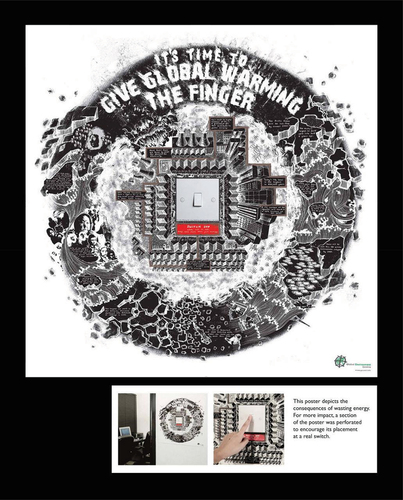
is a campaign by Global Environment Center, a nonprofit organization based in Malaysia. It shows a light switch inside a dark circle which contains a series of smaller images and short texts. In the right-hand corner, for example, a text can be read in the context of what seem to be pieces of floating ice: “The Arctic ocean will be ice free by 2050.” These images and texts are not metaphoric but rather describe expected future events as a result of global warming. The slogan says: “It’s time to give global warming the finger.” The campaign plays with the literal meaning of turning off the power switch and the implications that this has for saving energy and protecting the environment, and the figurative sense that by so doing, one behaves like a climate activist. This ambiguity is expanded upon further in the slogan, where the expression, “give the finger,” can be understood as an idiom referring to fighting global warming, but also literally, by using one’s finger to flip the switch. We have identified a multimodal metaphor here, ACTING AGAINST GLOBAL WARMING IS FLIPPING A SWITCH. The target domain is cued both visually (the represented effects of global warming surrounding the switch) and verbally (“global warming”) and the source is also cued visually (the switch) and verbally (“give the finger”). In this campaign we have identified two PART FOR WHOLE metonymies: switch for electricity and finger for person for activist. We have coded the projected value of this campaign as mixed, since it visually represents the (negative) effects of global warming and simultaneously invites the addressee to take action (positive).
Concrete entity
Concrete entities are used as source domains in the corpus to trigger highly incongruous mappings, such as in below. The campaigns collected in this category make use of resemblance metaphors, typically merging two entities into a new, impossible one (see Forceville’s (Citation2009) hybrid metaphors).
is a campaign by World Wildlife Fund which features the planet as a cone in a melting ice-cream. It is accompanied by the text: “The first signs of global warming are now clearly visible.” The text continues to urge readers to limit greenhouse emissions, claiming that “nothing and no-one will be spared from climate change.” We argue that a visual metaphor can be identified here, PLANET IS MELTING ICE-CREAM. Our general knowledge of the dangers that melting ice caps and rising sea levels represent as a result of global warming enables us to contextualize this metaphor. This inference is supported by the verbal mode, which constrains the potential of the visual information and confirms our intuition. As such, the theme of global warming/climate change, is accessed via an EFFECT FOR CAUSE and CATEGORY FOR SALIENT PROPERTY metonymic chain in the metaphoric source domain: melting for global warming for climate change for danger. The metonymic source is cued visually and, while we infer the target from the image, this is also specified in the text, leaving no doubts about the intended meaning. The value of this campaign is coded as negative, since the image and caption exclusively foreground the negative effects of global warming. No call to action is communicated in this campaign.
We now present and discuss the results of the quantification with regard to the research questions. First, we present a quantitative overview of the corpus as revealed by the analysis. Next, we present the results concerning metaphor (RQ1), metonymy (RQ2), the distribution of modes (RQ3), and value (RQ4).
RQ1: metaphorical conceptualization of main themes
The application of the procedure for the identification of metaphor and metonymy to our corpus revealed that all 51 campaigns make use of both metaphor and metonymy. As shown in (below), metonymy is the most frequent operation, with 88% of the campaigns yielding at least two metonymies (single or chains), while 92% of the campaigns cue only one metaphor related to the main themes studied.
Table 1. Identified metaphors and metonymies.
In terms of the main themes, pollution is the most frequently addressed theme in our corpus (see below). These themes do not necessarily coincide with metaphoric target domains, since the targets are frequently evoked via metonymy. However, the themes underpin the main rhetorical effects of the campaigns via different combinations of metaphor and metonymy interactions.
below displays the target domains of the annotated metaphors split into categories. The varied nature of these target domains is explained by the important role played by metonymy in providing access to the main theme in many campaigns (as illustrated earlier in ). This strategy is most typical of campaigns which make use of highly incongruous metaphorical images, which compare two concrete entities. As anticipated by the high number of campaigns in the corpus which address the theme of pollution (), (plastic) pollution is the most frequent target domain.
The distribution across the corpus of the five main metaphoric source domain categories proposed in this study is displayed in below. The three source domain categories, WAR, THREAT and NATURAL DISASTERS, imply an explicitly negative evaluation of the main themes (with the exception of the empowering implications of “fight global warming” and “beat air pollution” in the WAR category, discussed above). Together, these three categories make up half of the campaigns in the corpus (N = 26, 51%). The second half of the campaigns make use of source domains which tend to draw on our previous knowledge or familiarity with heterogeneous, everyday objects or activities, such as a melting ice-cream, a folding fan, leaving a legacy, or flipping a switch (categorized into CONCRETE ENTITY and ACTIONS/PLANS). Both categories predominantly rely on creative and highly incongruous mappings between target and source domain, with the CONCRETE ENTITY category lending itself to visual representation most naturally. The visual, verbal and verbopictorial manifestations of the source domain categories are presented in below.
Table 2. Source domain categories.
Examples of annotated metaphors classified into the CONCRETE ENTITY category are: CLIMATE CHANGE IS A SNOWGLOBE WITHOUT SNOW, AN AIRPLANE IS A (FLYING) PINEAPPLE, A MUTATED HUMAN IS A FISH and THE PLANET IS A SKULL.Footnote8 Examples from the ACTIONS/PLANS category are: GLOBAL WARMING IS LEAVING A LEGACY and CLIMATE CHANGE IS A FUTURE BUSINESS PROJECT.
RQ2: metonymy types
below collects the types of metonymies found in our corpus.
Table 3. Metonymy types.
The most frequent metonymy is the CAUSE EFFCT type (which includes both EFFECT FOR CAUSE and CAUSE FOR EFFECT metonymies), followed by PART-WHOLE (including PART FOR WHOLE and WHOLE FOR PART), CATEGORY FOR SALIENT PROPERTY and OBJECT FOR MATERIAL. The CAUSE-EFFECT metonymy type includes the results of processes, such as natural disasters as results of global warming and climate change, and the results of (human) action, which typically refer to the environmental damage caused by pollution. CAUSE-EFFECT metonymies also link climate change with the death and extinction of species (as effects of climate change) and with industrial activity and air pollution (as causes of climate change). The PART-WHOLE category comprises metonymies which depict human body parts and specific animals as a means of referring to persons, humanity and entire animal species. We have also annotated the PART-WHOLE category for metonymies arising from cultural and category-based associations, such as “grave for death” and “weapon for war.” CATEGORY FOR SALIENT PROPERTY metonymies trigger the emotional impact of many campaigns, such as the potential danger of weapons, predators and natural disasters, or a sense of disgust, for example, in campaigns which discuss how pollution enters the food chain. OBJECT FOR MATERIAL metonymies typically occur in campaigns which display plastic objects, which metonymically stand for the material or substance (plastic). These typically create metonymic chains of the type, OBJECT FOR MATERIAL - CAUSE FOR EFFECT, where the accumulation of plastic represents the cause of environmental pollution.
RQ3: distribution of metaphorical domains across modes
below shows that the majority of metaphors in our corpus are multimodal (verbopictorial) (N = 46, 84%), which coincides with the findings of previous research on both commercial and noncommercial advertising discourse (Forceville, Citation2009; Pérez-Sobrino, Citation2016a, Citation2016b; Pérez-Sobrino et al., Citation2021).
Furthermore, as shown in , multimodality occurs more frequently within metaphorical domains (within the source and/or the target, N = 41, 89%), rather than across the mapping (N = 5, 11%), where the metaphors cue their source and target domains in exclusively different modes. It is also interesting to observe that for almost half of the multimodal metaphors in the corpus (N = 21, 46%) multimodal cueing takes place both in the source and the target domains. This finding coincides with an observation by Pérez-Sobrino (Citation2016a), who suggests that multimodal cueing in both domains may be a representative feature of the genre of environmental awareness campaigns.
RQ4: projected value
The analysis reveals that a total of 47 (92%) of the campaigns contain units conveying negative value (either exclusively so or mixed with positive value), and that 4 (8%) activate exclusively positive value (see below). The campaigns which convey exclusively negative value do not call the audience to action but use figurativity to highlight the negative consequences of one of the main themes (e.g. in ). The campaigns which convey exclusively positive value, on the other hand, focus on the uniquely positive implications of climate activism. Most of the campaigns (N = 31, 61%), however, convey mixed value overall, meaning that they simultaneously convey a negatively-evaluated figurative message and a positive invitation to take action.
The findings related to the analysis of value in this corpus contrast with those in previous research related to commercial advertising, which emphasize that commercial ads make use of metaphor and metonymy to convey positive value about a target domain (the product). In our corpus, however, the metaphoric and metonymic operations, triggered by eye-catching visuals, are frequently responsible for highlighting the negative consequences of a target domain (an event or situation related to environmental harm). The campaigns frequently include a verbal message to empower audiences to prevent these consequences from taking place, which is usually relegated to the small print at the bottom or corner of the campaign. The emotional effect of these verbal messages on audiences, therefore, may not be as potent as the visuals, although further research in experimental settings is required to confirm this suggestion.
Conclusions and limitations of the study
The aim of the present study has been to conduct an exploratory analysis into the metaphoric and metonymic make-up of a corpus of noncommercial campaigns about climate change, global warming, pollution and activism. Our analysis has revealed how these themes are conceptualized and construed by means of metaphor and (its interaction with) single metonymies and metonymic chains. We complemented our analysis with an investigation into the role of multimodality in the cueing of metaphoric domains and into the projected value of each campaign.
Our analysis has revealed that five overarching frames are used in our corpus, WAR, THREAT, NATURAL DISASTERS, CONCRETE ENTITY and ACTIONS/PLANS. According to the source domain categories, half of the metaphors identified (N = 26, 51%) suggest a negative evaluation of global warming, climate change and pollution (by means of metaphors pertaining to WAR, THREAT and NATURAL DISASTERS. Source domains representing floods, droughts and hurricanes (NATURAL DISASTERS) are used to represent visually the effects of global warming and climate change. THREAT includes predators and traps, frequently representing the harmful effect of plastic objects, and also includes events such as drowning to represent the effects of rising sea levels as a cause of global warming. The WAR domain predominantly represents the potentially damaging effects of pollution, global warming and climate change on the environment, but also comprises some empowering linguistic metaphors related to fighting or beating global warming or pollution. The source domain categories CONCRETE ENTITY and ACTIONS/PLANS, generally reflect highly creative and incongruous mappings, which compare a theme (via metonymic inference or not) with familiar objects or activities. These generally give rise to visual or verbopictorial metaphors, such as PLASTIC BAGS ARE MARINE WILDLIFE (JELLYFISH), THE PLANET IS A MELTING ICE-CREAM and AN AIRPLANE IS A (FLYING) PINEAPPLE. Other source domains discussed in previous research, such as MACHINE or RELIGION, are not present in our corpus, which may point to the fact that source domain selection is genre-specific.
With regard to Research question 2, “What types of metonymies interact with the metaphors,” our research has found that the most frequent metonymies are CAUSE-EFFECT, PART-WHOLE, CATEGORY FOR SALIENT PROPERTY and OBJECT FOR MATERIAL. We suggest that these metonymies play important roles in the corpus by interacting with the metaphors in idiosyncratic ways and thereby making the metaphorical correspondences more meaningful. Firstly, the prevalence of CAUSE-EFFECT metonymies is crucial in highlighting the causes and negative effects of climate change and global warming. As pointed out by Herrero-Ruiz (Citation2018), EFFECT FOR CAUSE metonymies may easily trigger overstatements in such a way that only the worst foreseeable negative effects may be portrayed. Secondly, we suggest that CATEGORY FOR SALIENT PROPERTY relationships play a significant role in conveying the emotional impact of the campaigns, by highlighting features such as the danger of natural disasters, wars and predators. Thirdly, via PART-WHOLE and OBJECT FOR MATERIAL relations, specific metonymies highlight key aspects of the metaphorical domains, providing access to the overall figurative message and frequently linking ad-hoc visual metaphors to the main theme of the campaign. Metonymic chains also pervade the corpus and are responsible for much of the way in which meaning is compacted into one campaign.
With regard to Research question 3, “How are metaphoric source and target domains distributed across modes,” a key contribution of our research reveals that multimodality typically occurs within one or both metaphoric domains, rather than across the conceptual mapping. Therefore, although the majority of the metaphors identified in the corpus are prototypically verbopictorial in terms of Forceville’s (Citation2009, p. 24) classification (i.e. “metaphors whose target and source are each represented exclusively or predominantly in different modes”), it is more common for the source and/or the target to be cued simultaneously in the visual and verbal modes than for the source and target be represented in exclusively different modes. This finding has potentially interesting consequences for the study of text and image interactions in multimodal discourses and for research on the multimodal nature of figurative communication. Moreover, this finding is potentially indicative of a particular characteristic of the noncommercial advertising genre (Pérez-Sobrino, Citation2016a).
Finally, with regard to research question 4, “To what extent do the ads project value, and, if so, of what type,” the results of our study show that all but four of the campaigns convey explicitly negative value (N = 47, 92%), but that most also convey positive value, and therefore project what we term “mixed” value (N = 31, 61%). The analysis of value together with the identification of metaphor and metonymy have revealed some features of noncommercial environmental awareness campaigns which contrast to commercial advertising and which may prove characteristic of the noncommercial genre. These features pertain to the selection of threatening, negatively-evaluated source domains, and of negatively-valenced metonymic operations, particularly, CAUSE-EFFECT and CATEGORY FOR SALIENT PROPERTY, which frequently highlight negative causes and effects and negative properties of entities. The only campaigns which display exclusively positive value are four campaigns about climate activism.
The present study has some limitations, which may give rise to further research. First, the heterogeneous nature of the corpus, its size and the period during which it was collected prevents from making reliable generalizations regarding the nature of environmental awareness advertising as a discrete genre. Ideally, a larger corpus would be necessary, spanning a longer period of time, to explore in greater depth the strategies adopted by environmental awareness campaigns. It would also be interesting to focus only on specific NGOs or environmental themes. Nevertheless, this study makes a significant contribution to the field by constituting the largest corpus analysis of noncommercial campaigns from a cognitivist perspective, which addresses some themes which have not received sufficient attention in previous research, such as pollution. Second, in this study, metaphor and metonymy are the only cognitive operations addressed. However, other figurative operations occur in many of the campaigns, including hyperbole, irony and humor. Future studies could explore how these operations contribute to meaning construal and the characterization of the genre. Finally, future research should investigate experimentally the emotional effect of the campaigns, particularly the nature of the negative value that they project, and the potential effects of mixing negative value with empowering calls to action.
Acknowledgments
We are very grateful to the following NGOs, companies and organizations for granting us permission to reproduce the advertisements that have been used for discussion in this article: Surfrider Foundation, Surfers Against Sewage, Global 2000, Global Environment Centre and the World Wildlife Fund.
Disclosure statement
No potential conflict of interest was reported by the author(s).
Data availability statement
The annotated data, full protocol, scripts and output supporting the analyses and results presented in the paper (anonymized for peer review) can be found on the Open Science Framework Repository:
Additional information
Funding
Notes
1 XR is a “do-it-together-movement” that has played a major role in environmental activism globally since its inception in 2018. We view the XR posters in our corpus as performing a similar function to the rest of our corpus, as they share the purpose of raising public awareness about climate change and inciting the public to take action.
3 This followed the reviewer’s suggestions to clarify the procedure for the identification of metaphor and metonymy.
4 The complete procedure, together with the full reproducible R script, is accessible at:https://osf.io/uh8vf/
5 We are very grateful to Francisco Ruiz de Mendoza for pointing this out to us (personal communication, 12 October 2022).
6 For similar arguments on the defenselessness of nature in noncommercial campaigns on environmental awareness, see Pérez-Sobrino (Citation2016a).
7 Global 2000 is an independent Austrian environmental organization and a member of Friends of the Earth, the largest international network of environmental organizations.
8 It must be noted that some metaphors from the CONCRETE ENTITY and ACTIONS/PLANS categories also convey explicitly negative value (e.g. the skull) as per the annotation protocol, while some from the WAR, THREAT and NATURAL DISASTERS categories sometimes project positive value according to our annotation procedure (e.g. “fight climate change”). The distinction underlined here between the categories WAR, THREAT and NATURAL DISASTERS, which convey predominantly negative value, and those which foreground familiar objects and activities, is not intended as absolute. Rather, it illustrates a general trend in the data.
References
- Atanasova, D., & Koteyko, N. (2017). Metaphors in guardian online and mail online opinion-page content on climate change: War, religion, and politics. Environmental Communication, 11(4), 452–469. doi:10.1080/17524032.2015.1024705
- Augé, A. (2022). How visual metaphors can contradict verbal occurrences: A cross-linguistic and multimodal analysis of the imprint of climate change. Metaphor and the Social World, 12(1), 1–22. doi:10.1075/msw.20001.aug
- Cohen, M. J. (2011). Is the UK preparing for “war”? Military metaphors, personal carbon allowances, and consumption rationing in historical perspective. Climatic Change, 104(2), 199–222. doi:10.1007/s10584-009-9785-x
- Cozen, B. (2013). Mobilizing artists: Green patriot posters, visual metaphors, and climate change activism. Environmental Communication, 7(2), 297–314. doi:10.1080/17524032.2013.777353
- Cunningham, C., Foxcroft, C., & Sauntson, H. (2022). The divergent discourses of activists and politicians in the climate change debate: An ecolinguistic corpus analysis (pp. 18).
- Deignan, A. (2010). The evaluative properties of metaphors. In G. Low, Z. Todd, A. Deignan, & L. Cameron (Eds.), Researching and applying metaphor in the real world (pp. 357–374). John Benjamins Publishing Company. doi:10.1075/hcp.26.21dei
- Deignan, A., Semino, E., & Paul, S.-A. (2019). Metaphors of climate science in three genres: Research articles, educational texts, and secondary school student talk. Applied Linguistics, 40(2), 379–403. doi:10.1093/applin/amx035
- Domínguez, M. (2015). Evolution of metaphors: Phylogeny of oil slick cartoons in Spanish press. Discourse & Society, 26(2), 184–204. doi:10.1177/0957926514556208
- Doyle, J. (2007). Picturing the Clima(c)tic: Greenpeace and the representational politics of climate change communication. Science as Culture, 16(2), 129–150. doi:10.1080/09505430701368938
- Doyle, J. (2011). Mediating Climate Change. Ashgate Publishing, Ltd.
- Flusberg, S. J., Matlock, T., & Thibodeau, P. H. (2017). Metaphors for the War (or Race) against Climate Change. Environmental Communication, 11(6), 769–783. doi:10.1080/17524032.2017.1289111
- Forceville, C. (1996). Pictorial metaphor in advertising. Taylor & Francis Group.
- Forceville, C. (2009). Non-verbal and multimodal metaphor in a cognitivist framework: Agendas for research. In C. Forceville & E. Urios-Aparisi, (Eds.), Multimodal Metaphor, pp. 19–42. Mouton de Gruyter.
- Forceville, C. (2009). Non-verbal and multimodal metaphor in a cognitivist framwork. In C. Forceville & E. Urios-Aparisi (Eds.), Multimodal metaphor (pp. 19–42). De Gruyter.
- Forceville, C. (2012). Creativity in pictorial and multimodal advertising metaphors. In R. H. Jones (Ed.), Discourse and Creativity (pp. 113–132). Pearson.
- Forceville, C. (2017). Visual and multimodal metaphor in advertising: Cultural perspectives. Styles of Communication, 9, 26–41.
- Forceville, C., & Urios-Aparisi, E. (Eds.) (2009. Multimodal metaphor. Mouton de Gruyter.
- Fuoli, M., Littlemore, J., & Turner, S. (2021). Sunken ships and screaming banshees: Metaphor and evaluation in film reviews. English Language and Linguistics, 26(1), 75–103. doi:10.1017/S1360674321000046
- Goossens, L. (1995). Metaphonymy: The interaction of metaphor and metonymy in figurative expressions for linguistic action. In By word of mouth: Metaphor, metonymy, and linguistic action in a cognitive perspective. John Benjamins Publishing Company. https://benjamins.com/catalog/pbns.33.06goo
- Herrero-Ruiz, J. (2018). Exaggerating and mitigating through metonymy: The case of situational and CAUSE FOR EFFECT/EFFECT FOR CAUSE metonymies. Language & Communication, 62, 51–65. doi:10.1016/j.langcom.2018.07.001
- Hidalgo-Downing, L. (2020). Introduction: Towards an integrated framework for the analysis of metaphor and creativity in discourse. In L. Hidalgo-Downing & B. Kraljevic Mujic (Eds.), Performing metaphoric creativity across modes and contexts (pp. 1–17). John Benjamins Publishing Company.
- Hidalgo-Downing, L., & Kraljevic Mujic, B. (2011). Multimodal metonymy and metaphor as complex discourse resources for creativity in ICT advertising discourse. Review of Cognitive Linguistics, 9(1), 153–178. doi:10.1075/rcl.9.1.08hid
- Hidalgo-Downing, L., & Pérez-Sobrino, P. (2022). Developing an annotation protocol for evaluative stance and metaphor in discourse: Theoretical and methodological considerations. Text & Talk Advance online publication. doi:10.1515/text-2021-0096 .
- IPCC. (2021). Summary for policymakers. In climate change 2021: The physical science basis. contribution of working group i to the sixth assessment report of the intergovernmental panel on climate change (pp. 32). Cambridge University Press. doi:10.1017/9781009157896.001
- Kashanizadeh, Z., & Forceville, C. (2020). Visual and multimodal interaction of metaphor and metonymy: A study of Iranian and Dutch print advertisements. Cognitive Linguistic Studies, 7(1), 78–110. doi:10.1075/cogls.00050.kas
- Koteyko, N., & Atanasova, D. (2016). Metaphor and the representation of scientific issues. In E. Semino & Z. Demjén (Eds.), The Routledge handbook of metaphor and language. Routledge Handbooks Online. doi:10.4324/9781315672953.ch20
- Lakoff, G., & Johnson, M. (1980). W. a New Afterword Ed. Metaphors we live by. University of Chicago Press.
- Littlemore, J. (2015). Metonymy: Hidden Shortcuts in Language, Thought and Communication. Cambridge University Press. doi:10.1017/CBO9781107338814
- Littlemore, J., & Pérez-Sobrino, P. (2017). Eyelashes, speedometers or breasts? An experimental cross-cultural approach to multimodal metaphor and metonymy in advertising. Textus, 1, 197–222. doi:10.7370/87674
- Mühlhäusler, P. (1999). Metaphor and metonymy in environmental advertising. AAA: Arbeiten Aus Anglistik Und Amerikanistik, 24(2), 167–180.
- Nerlich, B., & Jaspal, R. (2012). Metaphors we die by? Geoengineering, metaphors, and the argument from catastrophe. Metaphor and Symbol, 27(2), 131–147. doi:10.1080/10926488.2012.665795
- Nerlich, B., Koteyko, N., & Brown, B. (2010). Theory and language of climate change communication. WIREs Climate Change, 1(1), 97–110. doi:10.1002/wcc.2
- Nisbet, M. C., & Mooney, C. (2007). Framing science. Science, 316(5821), 56. doi:10.1126/science.1142030
- Peña-Cervel, M. S., & Ruiz de Mendoza Ibáñez, F. J. (2022). Figuring out figuration: A cognitive linguistic account. John Benjamins Publishing Company.
- Pérez-Sobrino, P. (2016a). ‘Shockvertising’: Conceptual interaction patterns as constraints on advertising creativity. Círculo de Lingüística Aplicada a La Comunicación, 65, 257–290. doi:10.5209/rev_CLAC.2016.v65.51988
- Pérez-Sobrino, P. (2016b). Multimodal metaphor and metonymy in advertising: A corpus-based account. Metaphor and Symbol, 31(2), 73–90. doi:10.1080/10926488.2016.1150759
- Pérez-Sobrino, P. (2017). Multimodal metaphor and metonymy in advertising. John Benjamins. doi:10.1075/ftl.2
- Pérez-Sobrino, P., & Littlemore, J. (2020). What makes an advert go viral? The role of figurative operations in the success of Internet videos. In L. Hidalgo-Downing & B. Kraljevic-Mujic (Eds.), Performing metaphoric creativity across modes and contexts (pp. 119–152). John Benjamins Publishing Company. doi:10.1075/ftl.7.06per
- Pérez-Sobrino, P., Littlemore, J., & Ford, S. (2021). Unpacking creativity: The power of figurative communication in advertising. 1st. Cambridge University Press. 10.1017/9781108562409
- Pragglejaz Group. (2007). MIP: A method for identifying metaphorically used words in discourse. Metaphor and Symbol, 22(1), 1–39. doi:10.1080/10926480709336752
- Radden, G., & Kövecses, Z. (1999). Towards a theory of metonymy. In K.U. Panther & G. Radden (Eds.), Metonymy in language and thought (pp. 17–59). John Benjamins Publishing Company. doi:10.1075/hcp.4.03rad
- R Core Team. (2022). R: A language and environment for statistical computing (4.2.0). [R Foundation for Statistical Computing]. https://www.R-project.org/
- Ruiz de Mendoza Ibáñez, F. J., & Díez Velasco, O. I. (2002). Patterns of conceptual interaction. In Metaphor and metonymy in comparison and contrast (pp. 489–532). Mouton de Gruyter. doi:10.1515/9783110219197
- Ruiz de Mendoza Ibáñez, F. J., & Galera Masegosa, A. (2014). Cognitive modeling: A linguistic perspective. John Benjamins Publishing Company.
- Semino, E. (2008). Metaphor in Discourse. Cambridge University Press.
- Semino, E. (2021). “Not Soldiers but Fire-fighters” – Metaphors and Covid-19. Health Communication, 36(1), 50–58. doi:10.1080/10410236.2020.1844989
- Semino, E., Demjén, Z., Hardie, A., Payne, S., & Rayson, P. (2017). Metaphor, cancer and the end of life: A corpus-based study. Routledge. doi:10.4324/9781315629834
- Šorm, E., & Steen, G. J. (2018). VISMIP: Towards a method for visual metaphor identification. In G. J. Steen (Ed.), Visual metaphor: Structure and process (pp. 47–88). John Benjamins Publishing Company. doi:10.1075/celcr.18.03sor
- Steen, G. J., Dorst, A. G., Herrmann, J. B., Kaal, A., Krennmayr, T., & Pasma, T. (2010). A method for linguistic metaphor identification: From MIP to MIPVU. John Benjamins Publishing Company.
- Urios-Aparisi, E. (2009). Interaction of multimodal metaphor and metonymy in TV commercials: Four case studies. In C. Forceville & E. Urios-Aparisi (Eds.) Multimodal Metaphor (pp. 95–117). John Benjamins Publishing Company.
- Väliverronen E and Hellsten I. (2002). From “Burning Library” to “Green Medicine”. Science Communication, 24(2), 229–245. 10.1177/107554702237848
- Van der Hel, S., Hellsten, I., & Steen, G. (2018). Tipping points and climate change: Metaphor between science and the media. Environmental Communication, 12(5), 605–620. doi:10.1080/17524032.2017.1410198

